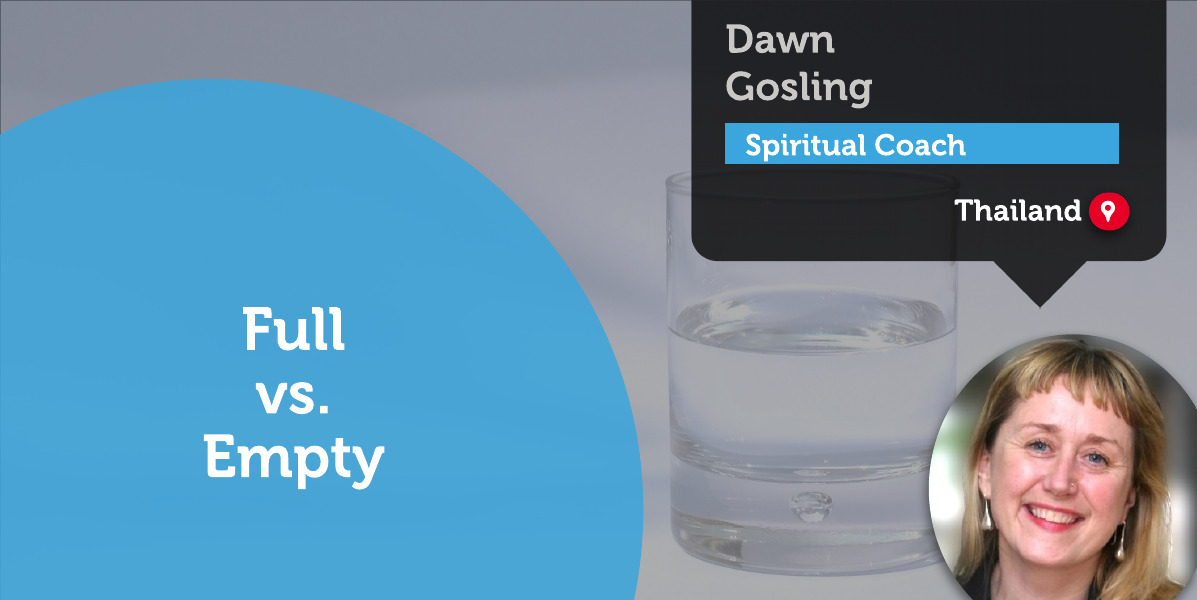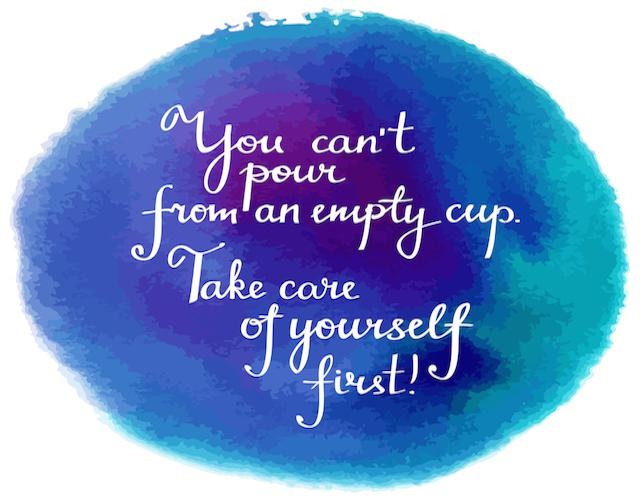A Coaching Power Tool Created by Dawn Gosling, Spiritual Coach, THAILAND

The Difference Between Half Full vs. Half Empty
Definition of full: Complete and expansive. Having an abundance of energy. Being content and happy.
Definition of empty: Exhausted. Being drained of energy. Having nothing to give to others and/or having nothing left for oneself. Feeling sad, unsatisfied, deprived, and depleted.

Modern life, with its endless demands at work and home, can leave many people feeling there’s just no more petrol left in their tank, resulting in a continuous feeling of being stressed. Time is our most precious commodity yet we never seem to have enough and always wish we had more. The pace of life continues to increase as electronic media becomes our default operating system and is completely changing all our social interactions.
With so many demands on our time and energy, it’s easy to feel run down, depleted, and exhausted. At times like these instead of focusing on refilling our own tank we often go into overdrive, prioritizing everything and everyone over ourselves. With only so many hours in a day, things that are important to our health and happiness are often the first things to fall off the to-do list.
To live a fulfilling life, you need to first make a difference in your own life, or as the air stewards advise us “please place the oxygen mask on yourself first before helping small children or others who may need your assistance”.

When we take care of ourselves deeply we naturally begin to care for others more healthily and effectively.
Often filling up our tanks takes more effort than merely having a massage once a month or a relaxing bath once a week. It usually requires us to look at our behavior and patterns. Patterns of self-sacrifice are quite common in people who reached this level of depletion. The first step in filling the tank could be learning how to say “NO”, setting limits, putting boundaries in place to protect time, energy, and emotional needs. However, this can be a difficult first step for people who are co-dependent or having never been taught to set boundaries.
Over giving can also be a sign of feeling empty – a signal that a need isn’t being met, emotion isn’t being expressed if a void isn’t getting filled.
 It’s also good to remember that when you let go of control and allow others to take the wheel, you empower them. You teach them to trust themselves, become resourceful, and take greater responsibility for the quality of their own lives.
It’s also good to remember that when you let go of control and allow others to take the wheel, you empower them. You teach them to trust themselves, become resourceful, and take greater responsibility for the quality of their own lives.
Allowing others to help means learning to surrender to the reality that there will be mistakes made and that things will not always get done your way.
Take a moment to focus on the word empty. Sit with it. Notice where it shows up in your body. Then after a few moments write down what you experienced / how you felt / what words would you use to describe empty.
By the time our tank is empty, we need to move into extreme self-care. Before we can do this the first step is often changing our mindset and shifting our belief that self-care is selfish.
- What areas of your life feel empty?
- In what areas are you overcommitting?
- What areas of your life could you surrender some control?
- How would you define extreme self-care?
- What would take time for self-care feel like?
- How could you spend more time on things or with people that energize you (fill your tank)?
- How could spend less time on things or with people that deplete your energy (drain your tank)?
Self-Care Tool: The Wheel of Life
A good starting place for working with the topic empty/full is the wheel of life as this gives a visual representation of where a client feels full or empty. The client can quickly see where she is out of balance and the coach can use the wheel to discuss the different areas of life (work/family/ finances / self-care) where the client may want to devote energy and other areas where they may need to pull back.
Using a blank wheel of life template ask the client to identify the 8 most important issues or key areas of life. Along each spoke ask the client to rate her current level of satisfaction:
10 = totally satisfied with that area of her life
1 = very dissatisfied with that area of her life

Use the wheel to drill down into each area to help the client understand their lives and issues more deeply.
Then repeat the exercise and this time ask the client to score her ideal level in each area.
Given time and energy are limited it’s helpful to get the client to identify which area of life she wants to focus on. Here are some examples of questions to help the client decide which area of her life need attention:
- What stands out for you when looking at your rankings on the wheel of life?
- What would the ideal level of attention be for you in each life area?
- What areas do you feel empty?
- Where are the gaps?
- What do you need more of right now?
- What do you need less of?
- What do you want right now? What are you yearning for?
- Who or what is causing you to feel resentful and why?
How to Apply the Wheel of Life in Coaching
After discussing the different areas of the wheel the next step is moving the client into action planning. Questions might sound like this:
- Starting with areas where you feel empty, what could you do today to regain balance/start filling up your tank?
- What is one thing you can do to make better use of your time so you eliminate the reason you feel so empty?
- What one routine could you put in place this week that would fill up your tank the most?
- What currently saps your energy and time, what can you stop doing, reprioritize or delegate?
- What are you most motivated to work on?
- When you think of filling your tank, what excites you the most?
- What’s holding you back?
- What are you afraid of?
- What support do you need to move ahead?
How to Set Boundaries in Your Coaching Practice
Most people cross your boundaries unwittingly rather than maliciously. When you begin to define your boundaries, most people will respect them. Having no boundaries and saying “YES” to everything is a common reason that people feel empty and depleted.
The first step in setting boundaries involves lifting the client’s level of awareness.
One of the best ways a client can begin to build this awareness is by noticing when she has an emotional reaction to something that someone said or done “to her”. This emotional reaction is usually because someone has crossed one of her personal boundaries.
Once you have identified some of the client’s boundaries that are regularly being crossed, you can then coach her through the process of defining her boundaries with other people.
As coaches, we can use role-playing to help the client get comfortable with saying “NO”. This simple process can quickly give clients some practical tools for managing difficult situations:
- Ask the client to visualize a recent situation where she wanted to say “NO” but out of guilt or obligation said “YES” instead.
- On a scale from 1 to 10, ask the client to rate how much did she really want to do this?
- Ask the client if she knew the person wouldn’t be angry, disappointed, or upset would she say “NO”?
- Finally, ask her to re-play (role play) the situation and practice saying “NO”.
Saying “NO” graceful could sound like:
- “I’d love to but I’m already committed to ….”
- “I only work Monday to Thursday and don’t work weekends, so you can contact me any time between those times”
- “It’s really kind of you to think of me. I like to give things my 100% and right now my priority is ‘X so I wouldn’t have the time to dedicate to it and give it the full attention it deserves”
- Offer an alternative… “I can’t do (date) but I could do (date) if that works for you?”
- “It’s a busy month. Let me check my diary when I’m back at home and I will send you over some possible dates.”
- “It’s not something that feels right for me but I could put you in touch with ….”
Once the client is clear about the things she wants to say “NO” to, it’s important to loop back to discuss what are the things she wants to say “YES” to (self-care / filling the tank).
When the client consistently makes choices and sets boundaries that help her create more balance and more quality in her life, she will start to feel more comfortable in saying “NO”. However, until that muscle is built maintaining boundaries often takes some time so it is normal for this work to take more than one coaching session.
Here are some suggested questions to help the client set herself up to succeed:

- What challenges can you foresee within maintaining these boundaries?
- How can you set yourself up to succeed?
- When or with who would it be most difficult to maintain your boundaries?
- What tools could you use to manage these situations?
- What is the most important boundary you need to set up?
- Is there anyone you need to have a conversation with about your new boundaries?
- What will you do if your boundaries are violated?
References
Finding Your Own North Star: Claiming the Life You Were Meant to Live
Get out of Your Own Way: Overcoming Self Defeating Behaviour
Dark Side of the Light Chasers
You Can Heal Your Life
Stand Up For Your Life
My Answer is No … If That’s OK With You
Difficult Conversations: How to Discuss what matters most
The Harvard Medical Schools Guide to a Good Nights Sleep
Mayday!: Asking for Help in Times of Need